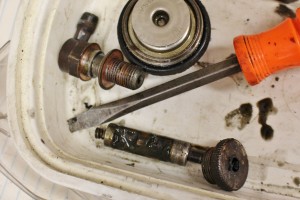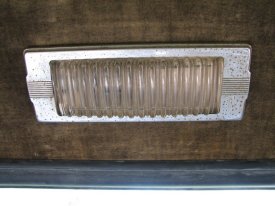-
Posts
271 -
Joined
-
Last visited
Content Type
Forums
Gallery
Events
Posts posted by nvonada
-
-
That big bolt is indeed a hollow "banjo bolt". Looks like you are getting close!
>

-
Good ones are hard to find.
-
Now I am hungry for bacon...
-
Does your oil smell like gas? Is it running out of the carb? Black smoke rolling out the back as you drive? I am not sure how you can get 3-4 MPG without the gas going SOMEWHERE it is not supposed to. Hopefully you just did not fill it up the whole way the first time. Just for reference I get about 20-22 in my Champion. My brick-shaped Jeepster with twice the horsepower gets more like 12-15 but I tend to put my foot in that too.
-
One wheel or all of them? This can have several causes (assuming the car has hydraulic brakes, which I think it does?)
- Weak return springs
- A failing flexible brake hose acting like a check valve
- Corrosion or bad wear in a brake cylinder causing the piston to hang
- If all wheels maybe a faulty residual pressure valve
Probably the thing to do is get the car on jacks and have someone hit the brakes while you spin each wheel to isolate the problem.
Nathan
-
Looks like a lot of the bolts broke off too. Good luck!
-
Yes, brakes were centered and adjusted. I will have to check them again just to be sure. What I really need is a break in the weather. I just don't want to go out when it is 10 degrees out!
-
No, fluid levels were fine.
-
This fall the brakes on my 41 Champion started to feel odd. The first time I pushed the pedal it would be a little soft but after that it would be fine for several minutes. Then it would be soft for one stroke again. The soft pedal was not an air-bubble sort of soft, more like when the brakes are really out of adjustment. I checked the adjustment and everything is good. My theory is that the residual pressure valve in the master cylinder was leaking. So I tore down the master cylinder and rebuilt it. Then the bottom dropped out of the thermometer and I have not been out since to finish bleeding the brakes so I don't know if I fixed the problem or not. The forced down time has me wondering if I did not jump the gun rebuilding the master. Any opinions? Besides the obvious that I should man up, brave the cold, bleed the brakes, and see for myself?
Nathan
-
You are way ahead of me. On a magneto ignition the switch grounds the magneto to prevent the plugs from firing, so you OPEN the switch to run the car (or plane, or lawnmower
 ). Glad you found the problem.
). Glad you found the problem.
-
Maybe it was not the durability of the car they were testing...
-
 1
1
-
-
Arm out the window is your best bet. Totally original! Your best improvement for safety is bright brake lights. Most on these old cars are horrible.
Nathan
-
 1
1
-
-
Every wire in your pictures has electrical tape wrapped around it. That does not mean the wiring is bad or incorrect. But it does mean it was messed with by someone. I would NOT leave the battery connected until you get the wiring sorted. That is a super cool car and it would be a shame if it burned up. For testing you should get a multimeter and learn to use it. It is not hard to use or expensive. Even a test light would be big help. Electric work is daunting at first but once you learn a few basic rules and concepts it is not that complicated.
Nathan
-
If you want a more authentic look in a modern belt get a tractor or lawn mower belt. NAPA or Tractor Supply are good sources. They look more like the old belts and are less likely to have teeth.
Nathan
-
 1
1
-
-
I hit that too when I was troubleshooting my voltage regulator. The rapid pulsing of the regulator threw my digital meter for a loop. However you can check voltage at the battery. The battery serves as a buffer and smooths things out. If you have a dwell meter they usually have a voltmeter mode. My old one died so I bought this one for a whopping $21. Works great:
https://www.amazon.com/gp/product/B00062YUUS/ref=oh_aui_detailpage_o00_s00?ie=UTF8&psc=1
Nathan
-
 1
1
-
-
I think that is an excellent solution. These are not high-efficiency pumps so those pits in the casting will be fine. I kept a 1973 Johnson outboard running for decades and those impellers do get hard and fail over 10 years or so. One consideration is that outboards are always pumping cold water. Running at engine temperature all the time might deteriorate the impeller faster.
Nathan
-
Easiest valve adjustment you will ever do
 . Looking good.
. Looking good.
-
 1
1
-
-
Nothing too toxic bug a dust mask might be a wise precaution. The insulation is (was?) cotton or maybe jute thread woven around the wire then sealed with some varnish. That dust is a combination of decomposed thread, varnish dust, and probably dried mouse pee. Yum!
-
I think the business coupe and 2/4 door sedans did the jack differently. My coupe is missing a jack but there is a canvas strap on the floor just under the latch handle that I think was intended to hold it. It holds my fire extinguisher now

Is this the light you are talking about?

I used to have a spare but sold it several years back. They show up on e-Pay now and again.
-
Steering, brakes, and handling are going to be terrible compared to any modern car. The question is are they terrible compared to 88 years ago?
Your local auto parts store will have "cable lube" which is just light oil with graphite in it. It works great but will stain so be careful around your interior. On both my old cars the speedometer cable followed the same sequence. The speedometer was bouncy, so I pulled the cable, cleaned it and lubed it. Everything seemed OK for a while then the cables broke. Once replaced everything has been good since.
My speedometer has a lubrication port above where the cable attaches. I don't know if you have one but if you do it probably has not been lubed since the car was new. If you have one a couple drops of light oil in there work wonders.
Nathan
-
 1
1
-
-
It sounds like you are making progress. In another thread you mentioned fuel pump issues. Low fuel pressure would possibly cause starving for gas at higher speeds. I think your car would have a diaphragm-style fuel pump. If so the rubber in there is probably older than dirt and may not be ethanol safe. Are pumps still available? I was shocked when the local NAPA had one in stock for my car. Maybe you will get lucky.
Nathan
-
 1
1
-
-
I don't have any experience with the really old cars but on my "newer" car burned points are one of two things:
- Voltage at the coil. There should a ballast resistor to lower the voltage to your coil. When you crank the engine the voltage of your system drops. So your coil is actually designed to put out as much as the points can handle while then engine is cranking. This means that when the engine is running you normally would be running way too high a voltage. The ballast resistor solves this problem. When the engine is running the power for the coil should go through the ballast resistor. A second wire should bypass the ballast resistor only when the engine is cranking. If someone removed or bypassed your ballast resistor then that is probably the problem.
- That big condenser capacitor on your points. I am a little fuzzy on why this is called a condenser but its job is to absorb big spikes when the points close and open. These fail and you get sparking across the points which will quickly damage them.
There is certainly a reason why we got away from the coil/points ignition system. When I depended on cars with points for daily transportation I kept a complete set of points, condenser, cap, rotor, and screwdriver in my car at all times and used them more than once.
Nathan
-
Moe is right. Nothing you have said so far says "pull the head". You have fuel or ignition problems to sort out first. The fact that it runs smooth in certain conditions means you have at least a marginally healthy engine.
-
You probably can. But if your current carb is not leaking why introduce another variable in your mix?





Buyer's Guide
in Studebaker, Erskine & Rockne
Posted
Studes are a great choice. Compared to the other independents we have excellent vendor support and parts supply. Unless you are looking for a long-term project avoid rusty cars. Assuming you are on a budget I would look for a solid car as original as possible and focus on getting it running. Too many people get a "new" project car, tear into it, then realize they don't have the time, skills, or money to finish and end up with a pile of car parts rather than a car. Turning Wheels and the Studebaker forms are a great place to start looking, lots of knowledge and cars for sale. Best of luck!
Nathan